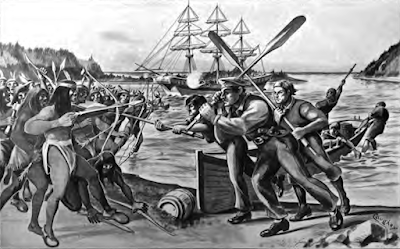A Deeper Look: Tillamook County
 |
| Captain Grey, Tillamook fight |
Timothy, my son, I am giving you this command in keeping with the prophecies once made about you, so that by recalling them you may fight the battle well, holding on to faith and a good conscience, which some have rejected and so have suffered shipwreck with regard to the faith. I Timothy 1:18-19 NIV
Tales of Spanish galleons and ancient shipwrecks are high on my list of distractions when it comes to historical research. The point of researching the history of an area, in this case Tillamook County, is to locate events that happened in the past that we can pray over or even repent – like the killings at Murderer’s Harbor - when that seems appropriate. The Oregon coastline is such a place of mystery, intrigue, romance, and adventure that distractions are inevitable. But, then, maybe there are things in those old stories to pray over after all?
 |
| Tillamook County, Oregon |
Tillamook County’s long coastline is part of the "Graveyard of the Pacific" mentioned in an earlier post, a strip of coastline from Tillamook Bay to Vancouver Island known for its dangerous weather and treacherous shoreline. It is difficult to think about Tillamook County without thinking about the Pacific and boats of all kinds, from the dory fleet at Pacific City to the exploring and trading vessels that sailed in the “olden days.”
The Bible mentions ships and the sea a lot. And a boat,
or barque, was an ancient Christian symbol of the church, tossed on the stormy
waves of the world.
While we earlier shared the story of the Norwegian schooner, Shuan,
that wrecked near Sandlake in Tillamook County in 1890, there are more ancient stories.
The Bees Wax Wreck, a very old wreck carrying large
quantities of bees wax and candles, has been known since early settlement days,
and more recently the Maritime Archeological Society has shed light on the mystery
of its origins.
For a couple of centuries, the Spanish had a trade
route from Manila, Philippines to Mexico and South America, supplying the
Spanish Catholic missions with bees wax for candles and returning with loads of
silver. In July of 1693 the Spanish galleon Santo Cristo de Burgos left
Manila for Acapulco, Mexico loaded with bees wax, candles, and Asian luxury
goods, and was never seen again. The Native Americans around Nehalem Spit,
about twenty miles north of Tillamook Bay, maintained that a large ship had
wrecked there many years before the first Americans arrived and bees wax,
candles and Chinese pottery shards had been scattered along the coast.
 |
| galleon |
This is likely the earliest known shipwreck in the Pacific
Northwest.
Another early maritime event for Tillamook County was
the arrival of Captain Robert Grey in 1788, discovering Tillamook Bay even
before his discovery of the mouth of the Columbia River in 1792. Captain Grey
was the first American to set foot in Oregon. His crew named the bay “Murderer Harbor”
due to a tragic altercation they had with the Native Americans. The interaction
with the Indians, apparently a misunderstanding over a knife, resulted in the
death of one crewmember and several Tillamook Indians.
The pioneers began settling the county in the 1850’s. Tillamook County has been a rural, and rather isolated, place of tough and independent fishermen, loggers, and dairymen - but it is also a very cosmopolitan place, with visitors and sailors washing up from all over the world. There are stories of the remains of Chinese junks being found as well as shipwrecks from other countries.
In praying for Tillamook County keep in mind those
early days, the trauma, loss, and grief of shipwreck
survivors, the injustices to the Native Americans. While “Murderer Harbor” was later changed “Tillamook Bay,” it marks what is probably the first killing of Native Americans by Europeans in Oregon.
The County government is made up of a three-person Commission.
Currently the Commissioners are Mary Faith Bell, David Yamamoto, and Erin
Skaar. In 2020 the Commissioners were faced with a cyber breach of the county
computer system and records by international cyber criminals. While they retrieved
as much of their sensitive records as possible, in the end they were obliged to
pay the $300,000 ransom.
How do we pray for Tillamook County?
Create a clean heart within me, O God; and
renew a steadfast spirit within me. Psalm 51:9
Pray for the Commissioners as they continue to ensure
the safety of the county systems and records.
Pray for the safety of modern sailors and fishermen
who make a living off the Tillamook coast.
Pray for an outpouring of the Holy Spirit in all the
towns of Tillamook County.



Comments
Post a Comment